Introduction
Platystele was first proposed by Schlechter (1910), and published in Repertorium Specierum Novarum Regni Vegetabilis. The name comes from the Greek “platys''and “stele''meaning “a broad column,''referring to the column of the type species, Platystele compacta Ames (Luer 1990). The genus comprises more than 120 species, with new species being discovered each year (Baquero & Galarza Verkovitch 2019, Baquero & Zuchan 2017, Jost & Iturralde 2017, Karremans 2016, Karremans & Bogarín 2017, Luer 1990, 1994, Reina-Rodríguez & Karremans 2018, Romero et al. 2018, Thoerle 2018, Vieira-Uribe & Karremans 2017). Karremans et al. (2016) found that, based on DNA analyses, Platystele is related to Andinia (Luer) Luer, Dryadella Luer, Muscarella Luer, Scaphosepalum Pfitzer, Specklinia Lindl., and Teagueia (Luer) Luer. Teagueia, with species previously belonging to Platystele, was segregated by Luer (1991) due to its much larger flowers, sepals with well-developed sepaline tails, and multiple veined, among other differences.
Platystele is distributed in the Neotropics, from the Trans-Mexican Volcanic Belt and the Antilles to South America as far south as Bolivia and ranging in elevation from 300 to 3600 m with the greatest number of species known from Ecuador and Colombia (Baquero & Galarza Verkovitch 2019, Baquero & Zuchan 2017, Jost & Iturralde 2017, Karremans & Bogarín 2017, Luer 1990, Reina-Rodríguez & Karremans 2018, Romero et al. 2018, Thoerle 2018). Ecuador is considered the center of diversity for the genus with almost 60 species, of which 35 are considered endemic (Baquero & Galarza Verkovitch 2019, Baquero & Zuchan 2017, Jost & Iturralde 2017, Romero et al. 2018, Thoerle 2018).
Species of Platystele can be easily recognized by their repent to caespitose plants, usually no more than 5 cm long, with petiolate, spatulate to obovate leaves, a filiform flower raceme which can be successively or simultaneously flowered, and varying from umbellate, congested, flexuous to distichous racemes borne at the base of the leaves and bearing miniature flowers, which are frequently flat, with free and spreading sepals and petals, a simple lip more or less cellularglandular, with a basal glenion (Luer 1990). The column is short and wide, with an apical anther and a bilobed stigma (Karremans & Bogarín 2017, Luer 1990, Thoerle 2018).
A group of species endemic to the northwest of Ecuador and southwest of Colombia (Baquero & Galarza Verkovitch 2019, Kolanowska 2012, Luer 1990, 1991, 1994) shares a combination of unique features, including a broad, incurved, wide column (reminiscent of a tiny and wide human nose), pubescent, broad flowers with ciliate to long ciliate margins of the petals and sepals. These species would be included in the informal “pubescens''group based on the first species described, Platystele pubescens Luer. The species included in this informal group are P. adelphe Luer & Hirtz, P. decouxii Baquero & G.Verkovitch, P. muscicola Luer & Hirtz, P. pubescens, P. scopulifera Luer & Dodson, and P. ximenae Luer & Hirtz (Baquero & Galarza Verkovitch 2019, Luer 1990, 1991, 1994). In the past few years, new species of Platystele have been recorded in northwestern Ecuador, like P. pamelae Baquero & Zuchan, P. cedriensis Baquero & G.Verkovitch, and P. decouxii (Baquero & Galarza Verkovitch 2019, Baquero & Zuchan 2017). Here, we provide a detailed description, a line illustration, color figures, and information about the ecology, distribution, and conservation status of another new species of Platystele from northwestern Ecuador.
Materials and methods
Expeditions were made in March and August 2021 with botanists and zoologists of Instituto Nacional de Biodiversidad (INABIO), Fundación EcoMinga, and Reserva: The Youth Land Trust, to characterize the flora and fauna of the Dracula reserve and the Bosque Comunal La Esperanza, Carchi, Ecuador.
Fresh material of the new species was photographed in situ with a Canon EOS T6 camera and a Canon EF-S 35/28 Macro lens. It was subsequently pressed, dried, and deposited at QCNE as part of a research project on orchids under Research Permit No. MAAE-ARSFC-2021-1102. Digital images taken in situ and fresh flowers preserved in 70% ethanol and 1% glycerol, herbarium specimens (QCNE, QCA), specialized bibliography like Luer (1990), Baquero & Galarza Verkovitch (2019), Kolanowska (2012) and original descriptions of the related Platystele species were review and compared. The description and drawings were prepared from living specimens. Figures and a composite digital line drawing were prepared based on the type specimen images using Adobe Photoshop® 2019. The distribution map was prepared using ArcGis Desktop 10.8.
Taxonomic Treatment
Platystele finleyae M.F.Monteros, E.Restrepo & Baquero, sp. nov. (Fig. 1 - 4).
TYPE: Ecuador. Carchi: La Esperanza, 1700m, 0°56'11.14''N, 78°14'33.86''W, 24 March 2021, M. Monteros 209 (holotype: QCNE!).
Diagnosis: Platystele finleyae is most similar to Platystele ximenae from which it can be easily distinguished by its vermilion to vinaceous flowers (vs. yellow, suffused with purple at the basal middle), with long ciliate petals (vs. shortly pubescent) and the elliptical-oblong lip (vs. transversely cordate).
Plant small, epiphytic, caespitose herb, up to 5 cm including inflorescence; roots slender ca. 0.3 mm in di ameter. Ramicauls erect to suberect, slender, 3-4 mm long, enclosed by 1-2 thin, ribbed, imbricating sheaths. Leaf erect to suberect, coriaceous, obovate, with the base narrowly attenuated into a petiole, 2.0-3.0 × 0.7-1.1 cm. Inflorescence erect and successively-flowered raceme, 3-5 cm long, including filiform peduncle 0.5 cm long, emerging low from the ramicaul; floral bracts acuminate, 1 mm long; pedicels 2.5 mm long. Ovary 6-ribed, 1 mm long. Sepals vermilion to vinaceous, glabrous towards the basal half and sparsely pubescent towards the apex, ciliate on the margins. Dorsal sepal broadly oblong, attenuate, long ciliate in the margins, subconvex, 1-veined, 2.0-2.5 × 1.5 mm. Lateral sepals broadly ovate, obtuse, slightly ciliate in the margins, connate at the base, 1-veined, 2.0 × 2.5 mm. Petals vermilion to vinaceous, oblanceolate, subfalcate, glabrous, acute, 2.0 × 1.0 mm, 1veined, longciliate from the middle to the apex. Lip flame-colored, oblong, elliptical, cellular-glandular, small deltate glenion at the base, with a rounded apex, 1.1 × 0.9-1.0 mm, with the rounded base inflexibly attached to the column. Column flame-colored to cream, short, incurved, stout semiterete 0.6 × 0.5 mm, anther ventral with the stigma subapical, reflexed, transversely bilobed on each side of the anther, the foot rudimentary. Anther cap yellowish, obovate, cucullate, 0.3 mm long. Fruits not seen.
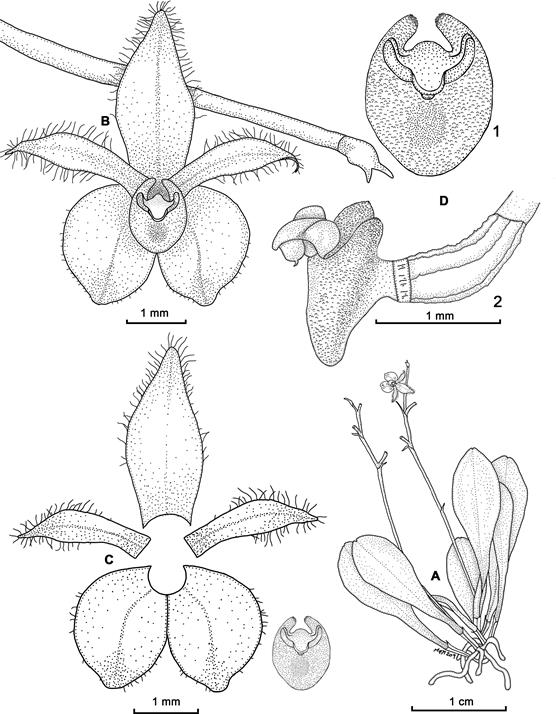
A. Habit.
B. Flower.
C. Dissected perianth.
D1. Column and lip, frontal view.
D2. Column, lip and ovary, lateral view.
Drawn by Marco F. Monteros from the plant that served as the holotype (MFM 209, QCNE).
Figure 1 Platystele finleyae M.F.Monteros, E.Restrepo & Baquero.
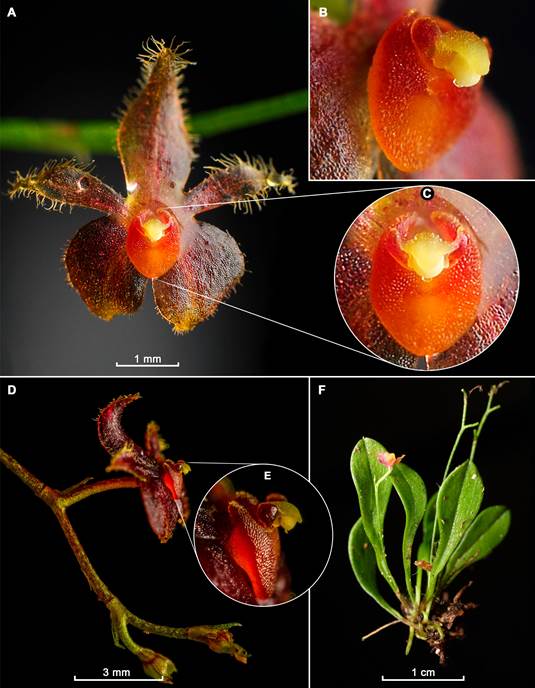
A. Flower, frontal view.
B. Close-up of the lip and column, – view.
C. Close-up of the lip and column, frontal view.
D. Inflorescence, lateral view.
E. Close-up of the lip and column, lateral view.
F. Habit.
Photographs by Marco F. Monteros (A-C, F) & Andrés Better (D-E) from the plant that served as the holotype (MFM 209, QCNE).
Prepared by Eugenio Restrepo.
Figure 2 Photographs of Platystele finleyae M.F.Monteros, E.Restrepo & Baquero
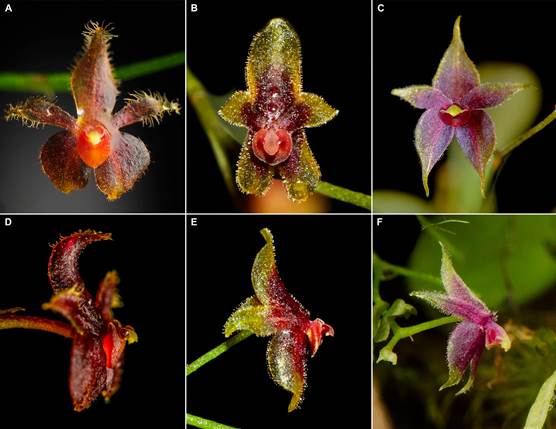
Photographs by Marco F. Monteros (A), Andrés Better (D), Kevin Holcomb (C, F), and Luis Baquero (B, E).
Prepared by Eugenio Restrepo.
Figure 3 Species comparison. Platystele finleyae M.F.Monteros, E.Restrepo & Baquero (A, D), Platystele ximenae Luer & Hirtz (B, E), Platystele adelphe Luer & Hirtz (C, F).
Paratype: Ecuador. Carchi: La Esperanza, 1700m, 0°56'11.03'' N, 78°14'33.91'' W, 2 August 2021, M. Monteros 210 (QCNE!).
Eponymy
The name honors Elizabeth Finley Broaddus, a young nature lover who inspired thousands of people to take action to conserve nature and fight against climate change. She set up her foundation, Finley's Green Leap Forward, to support local and global efforts that positively impact the environment. Further to encouraging individual action, Finley's efforts served as the inspiration behind the foundation of Reserva: The Youth Land Trust. This nonprofit organization has since established the world's first youthfunded nature reserve in northwestern Ecuador.
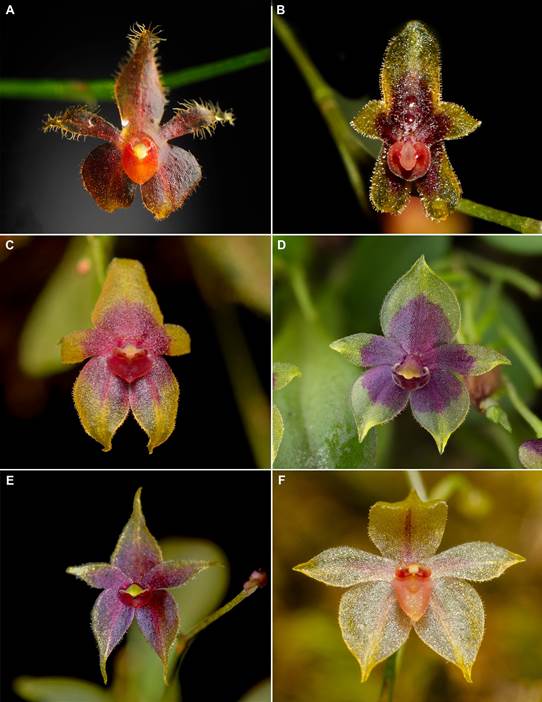
A. Platystele finleyae M.F.Monteros, E.Restrepo & Baquero.
B. Platystele ximenae Luer & Hirtz.
C. Platystele pubescens Luer.
D. Platystele scopulifera Luer & Dodson.
E. Platystele adelphe Luer & Hirtz.
F. Platystele decouxii Baquero & D.G.Verkovitch.
Photographs by Marco F. Monteros (A), Kevin Holcomb (B), Luis Baquero (C, E-F), and Gerrit Verhellen (D).
Prepared by Eugenio Restrepo.
Figure 4 Species within the “pubescens''informal group.
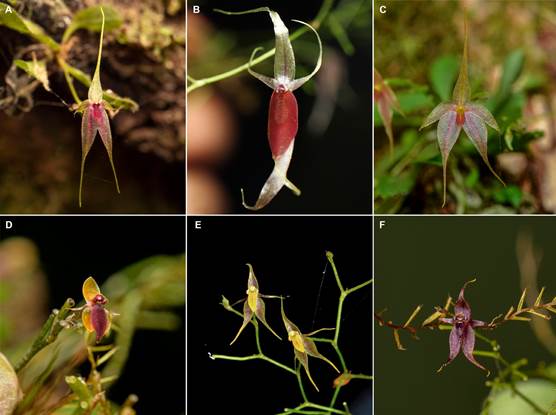
A. Platystele baqueroi Jost & Iturralde.
B. Platystele hirtzii Luer.
C. Platystele caudatisepala (C.Schweinf.) Garay.
D. Platystele filamentosa Luer.
E. Platystele pamelae Baquero & G.Verkovitch.
E. Platystele cf. alucitae Luer.
Photographs by Marco Monteros (A, B) and Luis Baquero (C-F).
Prepared by Eugenio Restrepo.
Figure 5 Other species of Platystele that have been recorded around the locality of Platystele finleyae M.F.Monteros, E.Restrepo & Baquero.
Habitat and ecology
Platystele finleyae was found growing in a poorly explored forest of northwestern Ecuador, near the limit of Fundación EcoMinga's Dracula Reserve, around 1711 m of elevation. According to the Ministerio del Ambiente del Ecuador (2013), this ecosystem is classified as a lower montane evergreen forest of the western Andes (BSBN04). This region of Ecuador is characterized by high biodiversity because it is influenced by two of the world's most diverse hotspots: Tumbes-Choco-Magdalena and Tropical Andes. Platystele finleyae grows epiphytically and shares the habitat with other Pleurothallidinae species such as Scaphosepalum swertiifolium Rchb.f., Masdevallia picturata Rchb.f., and Lepanthes hexapus Luer & R.Escobar.
Phenology: Plants of the species have been observed flowering in situ in March and August.
Platystele finleyae has flowers morphologically similar to P. ximenae in the pubescent flowers with broad, connate at the base, lateral sepals, and the lip with basal lobes surrounding the column (Fig. 3 B, E, 4B), but it is easily distinguished by the obovate leaves (vs. narrowly elliptical), the vermilion to vinaceous color of the flowers and its pattern (vs. yellow, suffused with purple towards the basal middle); the dorsal sepal broadly oblong, attenuate, long ciliate in the margins, subconvex (vs. elliptical, obtuse, shortly acuminate), and the lateral sepals obtuse, and slightly ciliate at the margins (vs. broadly ovate, oblique, obtuse, shortly acuminate, shortly pubescent). It also differs from P. ximenae by the integument of the petals, which is long ciliated (vs. short trichomes over the inner surface and margins, absent at the base), and the flame-colored lip, which is oblong, elliptical, rounded (vs. brown, transversely cordate, obtuse), narrower (0.9-1.0 mm vs. 1.4 mm), inflexibly attached to the column at the base (vs. with the basal lobes incurved and embracing the column).
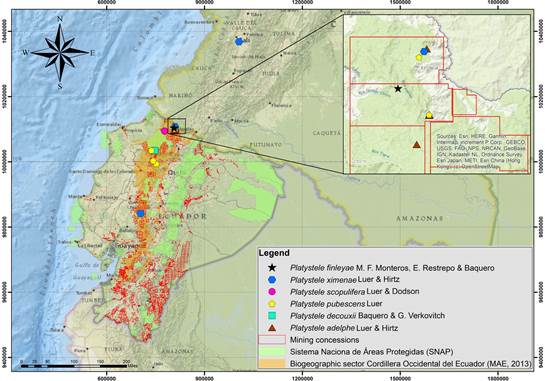
Map prepared by Marco F. Monteros.
Figure 6 The distribution of the species within the “pubescens''informal group based on literature and field data. The map shows a hotspot in Carchi province, northwest Ecuador. It also shows the considerable number of mining concessions around these localities.
Platystele finleyae appears to be related to other species belonging to the “pubescens''morphological informal group, like P. adelphe, P. decouxii, P. muscicola, P. pubescens, P. scopulifera, and P. ximenae (Baquero & Galarza Verkovitch 2019, Luer 1990, 1991, 1994). All these species are distributed in the biogeographic region of the western Andes of Ecuador and the southwestern Andes of Colombia in the Department of Valle del Cauca (Baquero & Verkovitch 2019, Kolanowska 2012, Luer 1990, 1994, Ministerio del Ambiente del Ecuador 2013). Most of these species are endemic to the biogeographic region of the Tropical Andes. Presumably, the highest diversity of this morphological informal group is restricted to the northwestern provinces of Carchi, Esmeraldas, and Imbabura, where Platystele adelphe, P. decouxii, P. muscicola, P. pubescens, P. scopulifera, P. ximenae, and P. finleyae grow (Fig. 6). Other species of Platystele are known to be close to the locality of Platystele finleyae, such as P. alucitae Luer, P. caudatisepala (C.Schweinf.) Garay, P. filamentosa Luer, P. hirtzii Luer, and P. pamelae Baquero & Zuchan(Baquero & Zuchan 2017, Jost & Iturralde 2017, Luer 1990), but none of them are morphologically similar to P. finleyae (Fig. 5).
Even though the Cordillera Occidental de Ecuador is an important biogeographic region for Ecuadorian biodiversity, it is currently strongly threatened by mining concessions, the lack of government-owned protected areas, and the illegal extraction of species. These threats put the conservation status of these species at risk (Monteros et al. 2021, Yánez-Muñoz et al. 2021). Therefore, it is necessary to evaluate their conservation status according to IUCN criteria, to focus on effective conservation actions (Fig. 6).
Conservation status
Although not yet evaluated, we suggest classifying this species as “Critically Endangered''following (UICN 2012) criteria B2ab(iii): area of occupancy estimated to be less than 10 km2; known to exist in no more than one locality, even though constant explorations have been carried out in this region during the last five years (Baquero & Monteros 2020, Baquero & Zuchan 2017, Jiménez et al. 2018, Monteros et al. 2021) and continuing decline, observed, inferred or projected, in area, extent, or quality of habitat. The main threats to this species are abrupt microclimate variations, habitat loss, and mining projects in the region (Fig. 6).












 uBio
uBio 


